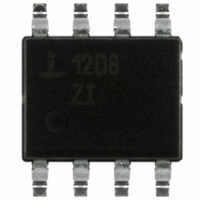ISL1208IB8Z-TK Intersil, ISL1208IB8Z-TK Datasheet - Page 12

ISL1208IB8Z-TK
Manufacturer Part Number
ISL1208IB8Z-TK
Description
IC RTC LP BATT BACKED SRAM 8SOIC
Manufacturer
Intersil
Type
Clock/Calendar/NVSRAMr
Datasheet
1.ISL1208IB8Z-TK.pdf
(24 pages)
Specifications of ISL1208IB8Z-TK
Memory Size
2B
Time Format
HH:MM:SS (12/24 hr)
Date Format
YY-MM-DD-dd
Interface
I²C, 2-Wire Serial
Voltage - Supply
2.7 V ~ 5.5 V
Operating Temperature
-40°C ~ 85°C
Mounting Type
Surface Mount
Package / Case
8-SOIC (3.9mm Width)
Lead Free Status / RoHS Status
Lead free / RoHS Compliant
Other names
ISL1208IB8Z-TKTR
Available stocks
Company
Part Number
Manufacturer
Quantity
Price
Company:
Part Number:
ISL1208IB8Z-TK
Manufacturer:
STC
Quantity:
1 000
Part Number:
ISL1208IB8Z-TK
Manufacturer:
INTERSIL
Quantity:
20 000
Real Time Clock Registers
Addresses [00h to 06h]
RTC REGISTERS (SC, MN, HR, DT, MO, YR, DW)
These registers depict BCD representations of the time. As
such, SC (Seconds) and MN (Minutes) range from 0 to 59,
HR (Hour) can either be a 12-hour or 24-hour mode, DT
(Date) is 1 to 31, MO (Month) is 1 to 12, YR (Year) is 0 to 99,
and DW (Day of the Week) is 0 to 6.
The DW register provides a Day of the Week status and uses
three bits DW2 to DW0 to represent the seven days of the
week. The counter advances in the cycle 0-1-2-3-4-5-6-0-1-
2-… The assignment of a numerical value to a specific day
of the week is arbitrary and may be decided by the system
software designer. The default value is defined as “0”.
24 HOUR TIME
If the MIL bit of the HR register is “1”, the RTC uses a 24-
hour format. If the MIL bit is “0”, the RTC uses a 12-hour
format and HR21 bit functions as an AM/PM indicator with a
“1” representing PM. The clock defaults to 12-hour format
time with HR21 = “0”.
LEAP YEARS
Leap years add the day February 29 and are defined as those
years that are divisible by 4. Years divisible by 100 are not leap
years, unless they are also divisible by 400. This means that
the year 2000 is a leap year, the year 2100 is not. The ISL1208
does not correct for the leap year in the year 2100.
Control and Status Registers
Addresses [07h to 0Bh]
The Control and Status Registers consist of the Status
Register, Interrupt and Alarm Register, Analog Trimming and
Digital Trimming Registers.
Status Register (SR)
The Status Register is located in the memory map at
address 07h. This is a volatile register that provides either
control or status of RTC failure, battery mode, alarm trigger,
write protection of clock counter, crystal oscillator enable and
auto reset of status bits.
Default
ADDR
07h
ARST XTOSCB reserved WRTC reserved ALM BAT RTCF
7
0
TABLE 2. STATUS REGISTER (SR)
6
0
5
0
12
4
0
3
0
2
0
1
0
0
0
ISL1208
REAL TIME CLOCK FAIL BIT (RTCF)
This bit is set to a “1” after a total power failure. This is a read
only bit that is set by hardware (ISL1208 internally) when the
device powers up after having lost all power to the device
(both V
whether V
the supplies does not set the RTCF bit to “1”. On power-up
after a total power failure, all registers are set to their default
states and the clock will not increment until at least one byte
is written to the clock register. The first valid write to the RTC
section after a complete power failure resets the RTCF bit to
“0” (writing one byte is sufficient).
BATTERY BIT (BAT)
This bit is set to a “1” when the device enters battery backup
mode. This bit can be reset either manually by the user or
automatically reset by enabling the auto-reset bit (see ARST
bit). A write to this bit in the SR can only set it to “0”, not “1”.
ALARM BIT (ALM)
These bits announce if the alarm matches the real time
clock. If there is a match, the respective bit is set to “1”. This
bit can be manually reset to “0” by the user or automatically
reset by enabling the auto-reset bit (see ARST bit). A write to
this bit in the SR can only set it to “0”, not “1”.
NOTE: An alarm bit that is set by an alarm occurring during an SR
read operation will remain set after the read operation is complete.
WRITE RTC ENABLE BIT (WRTC)
The WRTC bit enables or disables write capability into the
RTC Timing Registers. The factory default setting of this bit
is “0”. Upon initialization or power-up, the WRTC must be set
to “1” to enable the RTC. Upon the completion of a valid
write (STOP), the RTC starts counting. The RTC internal
1Hz signal is synchronized to the STOP condition during a
valid write cycle.
CRYSTAL OSCILLATOR ENABLE BIT (XTOSCB)
This bit enables/disables the internal crystal oscillator. When
the XTOSCB is set to “1”, the oscillator is disabled, and the
X1 pin allows for an external 32kHz signal to drive the RTC.
The XTOSCB bit is set to “0” on power-up.
AUTO RESET ENABLE BIT (ARST)
This bit enables/disables the automatic reset of the BAT and
ALM status bits only. When ARST bit is set to “1”, these
status bits are reset to “0” after a valid read of the respective
status register (with a valid STOP condition). When the
ARST is cleared to “0”, the user must manually reset the
BAT and ALM bits.
Interrupt Control Register (INT)
08h
Default
ADDR
TABLE 3. INTERRUPT CONTROL REGISTER (INT)
DD
IM ALME LPMODE FOBATB FO3 FO2 FO1 FO0
7
0
DD
and V
or V
6
0
BAT
BAT
go to 0V). The bit is set regardless of
is applied first. The loss of only one of
5
0
4
0
3
0
September 12, 2008
2
0
1
0
FN8085.8
0
0












